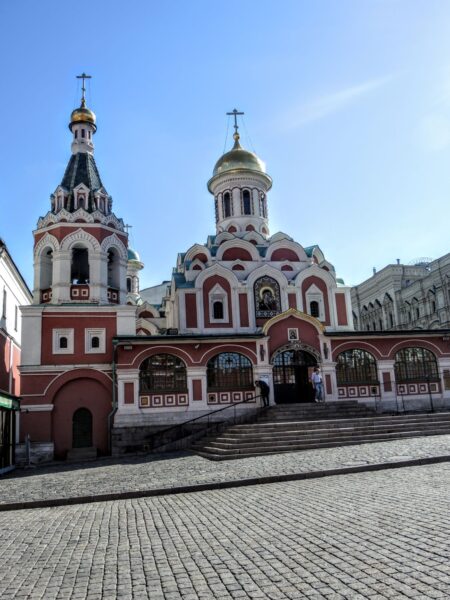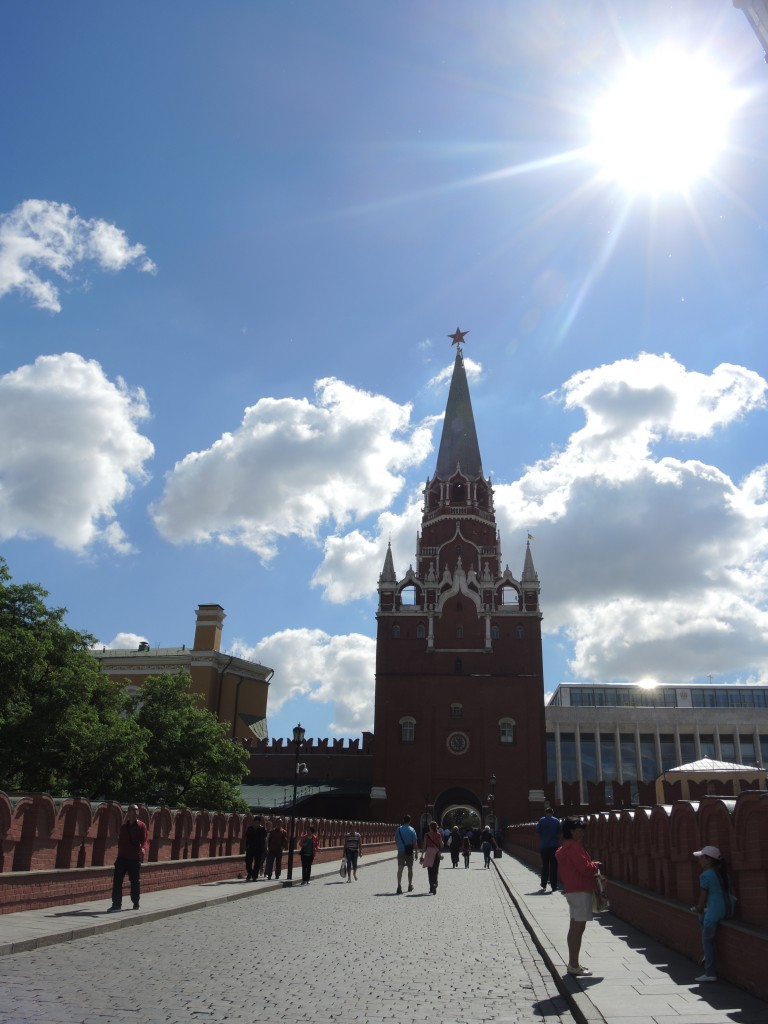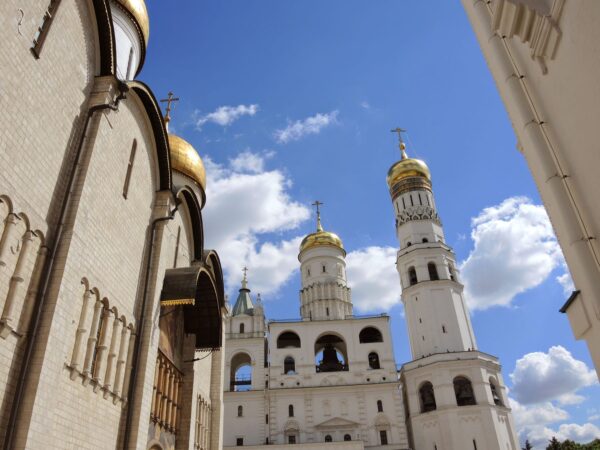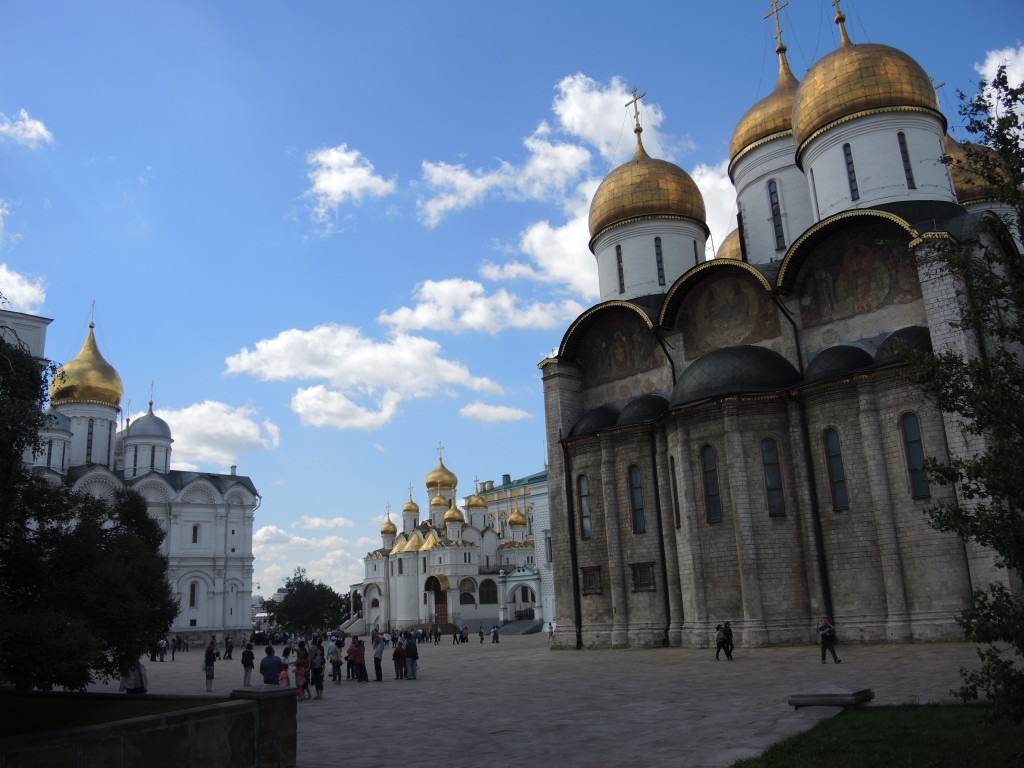18 June.
Today is off to a fairly easy start. We’re leaving the hotel around 08:00 to try to get a good spot in the queue to visit Lenin’s Tomb. The mausoleum opens at 10:00 but the line often forms early. For some reason, today wasn’t busy and we were among the first in line so we were able to go off in shifts to take some pictures of Red Square while the light was good and before the crowds arrived.
While we were standing in line, Groud told us what to expect. No photos. No stopping. Just shuffle past the corpse in a dimly lit room. I decided to give it a miss. I mean, what had Lenin ever done for me? Besides, I’d seen my share of dead people yesterday even if I hadn’t seen their actual corpses. So, I sat with G at the McDonalds across from Red Square while she tended everyone’s day packs because those aren’t allowed in Lenin’s shrine either. For me, a cup of tea was simply a better option. For you maybe it’s some photos such as this one.

Our guide for the day was Marina. It seemed as though she knew the Kremlin well and she’d spend the morning talking very fast as if to prove it. (If you recall, I had a rant about touring like this in my Tiananmen Square post.) Of course, I knew a few things, too. After we’d passed through security and she had us standing on the little footbridge just outside the Kremlin gate, she asked a general question about the kremlin. In this instance, the lower case ‘k’ is deliberate because as I knew and stated kremlin means fort and many cities in Russia have a kremlin.
Americans have come to equate the kremlin with Moscow’s Kremlin, because of its association with Russian, Soviet, and Russian governments in similar fashion to many foreigners who think of the White House as a symbol of American government despite the fact that there are many white houses in the United States. I also knew that the Kremlin (capital ‘K’ Kremlin will hereafter refer to Moscow Kremlin) was the place where Moscow was founded and that Kiev had been the capital prior to Moscow. There was also a lot I didn’t know: The Moscow Kremlin was initially built in the twelfth century at the confluence of two rivers – the Moscva and the Neglinnaya. The latter has been forced underground and the bridge on which we stood crossed it. 
Moscow became the capital of Russia in the fourteenth century after the final defeat of the Tatars and Mongols. The Moscow structure is about 28 hectares (69 acres). Not a bad size, but for comparison, Tiananmen Square is 44 hectares and the Imperial City is nearly one hundred. Although the two are adjacent, there is no access between Red Square and the Kremlin. Red Square, by the way, was so named because of it’s proximity to the church commonly called Saint Basil’s. The Russian word красная (krasnaya) meaning red was at one time also a synonym for beautiful and the square has likely held that name since some time in the seventeenth century.
Okay, now it’s time for you to imagine me as Marina as I rush through some facts about the Kremlin more or less following the sequence of pictures in this album.
- The Kremlin walls and towers were built between the years 1485 and 1495. The walls vary between 5 and 19 meters in height and between 3 and 6.5 meters in thickness.
- The yellow building is called the Arsenal. It was built in the 18th century and now serves as the barracks for the Kremlin Regiment. The guard outside the gate is in that regiment.
- The State Kremlin Palace was constructed under Nikita Khrushchev. The main hall, now a theater, can hold 6,000 people.
- The Kremlin Senate, built in the late eighteenth century, is now the Russian Presidential administration.
- The Tsar Cannon – a 40-ton cannon cast in 1586 – is the largest caliber cannon in the world. It might never have been fired or it might have been fired once but not in war.
- Only Russian Orthodox churches and cathedrals are permitted on the grounds and there are five of these structures in the Kremlin. Four of these can be found on Cathedral Square which is considered by some to be the heart of the Kremlin.
Three are visible in the photo above. Dominating this picture is the oldest cathedral in the fortress – the Cathedral of the Dormition. It was built in 1479 and was the site of the coronation of all tsars. The Cathedral of the Archangel (to the left), completed in 1508, is the youngest of the three and is the site where tsars are interred. The nine domed Cathedral of the Annunciation was finished in 1489 and was the site of the royal family baptisms. The Church of the Deposition is a small church and was largely a private chapel for the Patriarch of Moscow until it was appropriated by the royal family in the middle of the 17th century. Just off Cathedral Square is the only other church in the Kremlin, the Church of the Twelve Apostles, about which I can only tell you that it’s a “domestic” church meaning it wasn’t commissioned by the royal family.
Also on Cathedral Square is the Faceted Chamber or Palace of the Facets. It is the oldest secular building in the Kremlin with a completion date in 1491. Currently, it’s used to receive foreign ambassadors and for state receptions. It was also (I think) a place where the Tsars stood to greet their subjects.
The other notable structure on Cathedral Square is the Ivan the Great Bell Tower Complex.

None of the cathedrals on the square have their own bell towers so this complex was built to serve that purpose for all three. From its completion in 1508 until sometime after the Bolshevik revolution of 1917, this was, at 81-meters, the tallest structure in Moscow.
Leaving the square, we made our way to the gardens. There we saw an oak tree planted by Yuri Gagarin who, for the youngsters among you, was the first person to orbit the earth. Gagarin is buried inside the Kremlin walls. Interestingly, his daughter Elena is now curator of the Kremlin museums.
Both Lenin and Stalin had their residence in the Kremlin and during that time it was closed to the public. Beginning in 1955 with what is known as the Khrushchev thaw, some parts of the Kremlin have opened to visitors and Russian leaders have lived elsewhere. When the Russian President commuted to work, his motorcade caused significant traffic tie-ups in Moscow. To ease the congestion (or perhaps to flatter his ego), Vladimir Putin ordered construction of a helipad. It opened officially in May 2013.
The yellow and white building on the right in the next photograph in the folder is the Armory. This building originated as the royal arsenal in 1508 and three centuries later became a museum. Today, in addition to royal carriages, clothing, weapons, and armor, it houses ten imperial Fabergé eggs.
By the time the tour ended, I’d so impressed Marina with my knowledge and curiosity plus the dozen or so Russian words I know, that she presented me with a small book about the Fabergé eggs.
We exited the tour and met Groud outside. She offered to guide us to someplace we could have lunch. We accepted greedily because of our hunger and unfamiliarity with Moscow. As we were walking around the Kremlin back toward Red Square, we passed the Tomb of the Unknowns during
the Changing of the Guard so of course we momentarily suppressed our hunger, stopped to watch, and snap some pictures.
Groud took us to ГУМ (pronounced “goom” and usually transliterated GUM). This store, on the eastern side of Red Square, became famous during the Soviet era for its massively long lines stretching across the square because it was the only place that rarely had no shortages of goods. It originally opened in 1893 and its façade along Red Square is over 240 meters (790 feet) long. It was once considered to be the largest department store in the world. It’s now both a tourist attraction and a fashionable, upscale, somewhat pricey shopping mall so I took a handful of pictures mostly to show my father since he’d visited there in the early seventies.
One of the benefits of having G as a group leader is her considerable knowledge of where to find cheap eats – even in GUM. It was another cafeteria style establishment similar to the one in Yekaterinburg but this was quite busy. The food choices were traditional Russian which was fine with most of us. The best part, however, was that you chose your dessert first.
Come back tomorrow if you’d like to read about Erin and Todd’s afternoon adventure at the Tolstoy Estate and Museum as well as our somewhat trippy trip to Gorky Park.


So the classic multi-turret towers we typically see as a Moscow landmark are actually churches? Interesting in a county that declined to acknowledge religions during comunism (do I have that right, Todd?)… The Soviet Union/Russia has undergone so many changes in such a short time. I used to work with a guy who fled the Soviet Union when it dissolved and was able to get refugee status in the US. He had formerly been a history professor at a college and he was constantly lamenting the changes in Russia. He liked having things predictable and stable and known even if there was the downside in terms of resources. I had never considered that perspective and have always wondered how many Russians feel the same way.
I think no religious recognition was, indeed, the official government policy. And, of course, under Stalin, the government spent a lot of time tearing down churches as they did in Mongolia under Choibalsan.
Curious – how do you manage foreign language characters in the text? Good call on the Lenin viewing. Very interesting historical information in this post.
I don’t know how this works for an Apple user but in MS Word, you use the Insert menu then choose symbol. It has Cyrillic, Greek, Hebrew, all kinds of stuff.